The History Book Club discussion
ART - ARCHITECTURE - CULTURE
>
ARCHITECTURE
The Curious Life of Robert Hooke: The Man Who Measured London
 by Lisa Jardine
by Lisa Jardine
Publisher's Synopsis
The brilliant, largely forgotten maverick Robert Hooke was an engineer, surveyor, architect, and inventor who worked tirelessly with his intimate friend Christopher Wren to rebuild London after the Great Fire of 1666.He was the first Curator of Experiments at the Royal Society, and his engravings of natural phenomena seen under the new microscope appeared in his masterpiece, the acclaimed Micrographia, one of the most influential volumes of the day.
But Hooke's irascible temper and his passionate idealism provedfatal for his relationships with important political figures, most notably Sir Isaac Newton: their quarrel is legendary. As a result, historical greatness eluded Robert Hooke. Now, eminent historian Lisa Jardine does this original thinker of indefatigable curiosity and imagination justice and allows him to take his place as a major figure in the seventeenth century intellectual and scientific revolution.
 by Lisa Jardine
by Lisa JardinePublisher's Synopsis
The brilliant, largely forgotten maverick Robert Hooke was an engineer, surveyor, architect, and inventor who worked tirelessly with his intimate friend Christopher Wren to rebuild London after the Great Fire of 1666.He was the first Curator of Experiments at the Royal Society, and his engravings of natural phenomena seen under the new microscope appeared in his masterpiece, the acclaimed Micrographia, one of the most influential volumes of the day.
But Hooke's irascible temper and his passionate idealism provedfatal for his relationships with important political figures, most notably Sir Isaac Newton: their quarrel is legendary. As a result, historical greatness eluded Robert Hooke. Now, eminent historian Lisa Jardine does this original thinker of indefatigable curiosity and imagination justice and allows him to take his place as a major figure in the seventeenth century intellectual and scientific revolution.
 On February 27, 2012, Chinese architect Wang Shu won the Pritzker Prize, architecture's most prestigious honor. Wang, 48, was educated and spent his whole career in China. His projects often include materials salvaged from other buildings to make way for new construction. He is the second Chinese-born architect to win the prize. The first was I.M. Pei, who was educated and spent his whole career in the West.
On February 27, 2012, Chinese architect Wang Shu won the Pritzker Prize, architecture's most prestigious honor. Wang, 48, was educated and spent his whole career in China. His projects often include materials salvaged from other buildings to make way for new construction. He is the second Chinese-born architect to win the prize. The first was I.M. Pei, who was educated and spent his whole career in the West.
Wang Shu

Ningbo Tengtou Pavilion, Shanghai China

Ceramic House, Jinhua, China

Ningbo History Museum, Ningbo, China
The above are just a taste of Wang's spare, beautiful work.
You can see many more images of his projects, as well as the work of past prize winners, at the Pritzker Prize website: http://www.pritzkerprize.com/
Some books on post-modern architecture:
 by Charles Jencks (no author image)
by Charles Jencks (no author image) by Paul Goldberger (no author image)
by Paul Goldberger (no author image)I.M. Pei
 My favorite building in NYC and in my top 10 of all buildings is the elegant Chrysler Building in Manhattan. Built in 1930, it is the epitome of Art Deco, designed by William van Alen. It was dismissed as "kitschy" when it was first erected but has since been recognized as the ultimate in the Art Deco style and has been designated as a National Historic Landmark. Built of "Nirosta" (stainless steel) it can be seen from almost anywhere on the island and, with the destruction of the World Trade Center is now the second tallest building in the City, only topped by the Empire State Building. It is absolutely stunning.
My favorite building in NYC and in my top 10 of all buildings is the elegant Chrysler Building in Manhattan. Built in 1930, it is the epitome of Art Deco, designed by William van Alen. It was dismissed as "kitschy" when it was first erected but has since been recognized as the ultimate in the Art Deco style and has been designated as a National Historic Landmark. Built of "Nirosta" (stainless steel) it can be seen from almost anywhere on the island and, with the destruction of the World Trade Center is now the second tallest building in the City, only topped by the Empire State Building. It is absolutely stunning.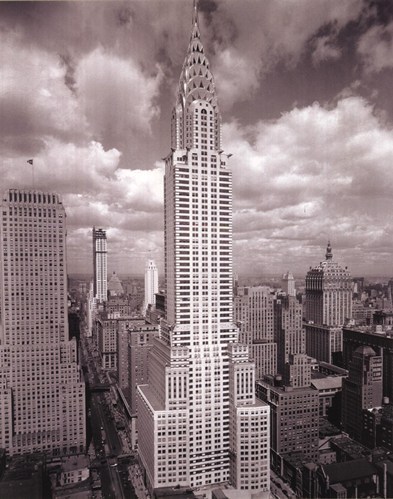
 Jill wrote: "My favorite building in NYC and in my top 10 of all buildings is the elegant Chrysler Building in Manhattan. Built in 1930, it is the epitome of Art Deco, designed by William van Alen. It was dismi..."
Jill wrote: "My favorite building in NYC and in my top 10 of all buildings is the elegant Chrysler Building in Manhattan. Built in 1930, it is the epitome of Art Deco, designed by William van Alen. It was dismi..."I couldn't agree more. There is something about Art Deco that delights my eyes.
 Bea, one of my favorite cities for art deco era architecture is San Francisco. It's everywhere!
Bea, one of my favorite cities for art deco era architecture is San Francisco. It's everywhere!  by Michael F. Crowe
by Michael F. Croweand perhaps one of the greatest structures ever ~
 by
by
 Kevin Starr
Kevin Starr
 Ooh, I need to check both books out. I lived in San Francisco in the early '80's and it was one of the happiest times of my life.
Ooh, I need to check both books out. I lived in San Francisco in the early '80's and it was one of the happiest times of my life.Another great area for Art Deco architecture is South Beach, Miami, Florida.
http://www.visitsouthbeachonline.com/...
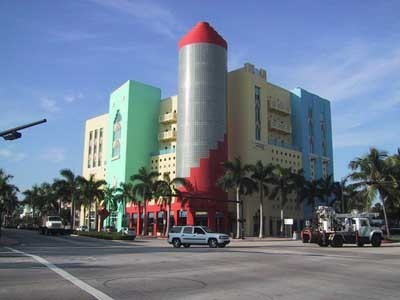


 by Richard Beaubien (no author image)
by Richard Beaubien (no author image)
 I am so thankful that the wonderful bijou hotels in South Beach have been saved and recognized as true architectural treasures. That neighborhood is amazing. It is obvious that we all have an affinity for the Art Deco style!!
I am so thankful that the wonderful bijou hotels in South Beach have been saved and recognized as true architectural treasures. That neighborhood is amazing. It is obvious that we all have an affinity for the Art Deco style!!Another beautiful example is Le Grand Rex Theatre in Paris.

 Introducing: Structure of the Week
Introducing: Structure of the WeekI think we have a critical mass of architecture/eye candy lovers in this group. Thought it might be nice to see if we can get a discussion going on the history of architecture.
I envision posting a photo or photos from a period each week with some books and other info to check out. I will pick my structure according to my whim and hope others will either respond or post their own structures of the week.
One of my favorite books on art in general is What is Art? by John Canaday. He suggests asking the following questions as bases for the judgment of architecture:
Functional efficiency How well does the building/structure work?
Aesthetic quality Is it good to look at?
Materials and site Is the most made of their potentials?
Humanistic record Does acquaintance with the building/structure clarify, intensify, or enlarge our experience through its character as an expression of its time?
 John Edwin Canaday (no photo)
John Edwin Canaday (no photo)A couple of highly rated overview histories of architecture that look good:
 by Marian Moffett (no photo)
by Marian Moffett (no photo) by Francis D.K. Ching (no photo)
by Francis D.K. Ching (no photo)
 My whim of the week is to start near the beginning with a neolithic structure.
My whim of the week is to start near the beginning with a neolithic structure.Stonehenge is a prehistoric monument located in the English county of Wiltshire. One of the most famous sites in the world, Stonehenge is composed of a circular setting of large standing stones set within earthworks. It is at the centre of the most dense complex of Neolithic and Bronze Age monuments in England.
Radiocarbon dating in 2008 suggested that the first stones were erected in 2400–2200 BC, while another theory suggests that bluestones may have been erected at the site as early as 3000 BC. The surrounding circular earth bank and ditch, which constitute the earliest phase of the monument, have been dated to about 3100 BC.
Stonehenge was produced by a culture that left no written records. Many aspects of Stonehenge remain subject to debate. Proposed functions for the site include usage as an astronomical observatory, or as a religious site.
There is little or no direct evidence for the construction techniques used by the Stonehenge builders. However, conventional techniques using Neolithic technology have been demonstrably effective at moving and placing stones of a similar size.
What can we say about Stonehenge using Canaday's framework?
Functional efficiency How well does the building/structure work?
Aesthetic quality Is it good to look at?
Materials and site Is the most made of their potentials?
Humanistic record Does acquaintance with the building/structure clarify, intensify, or enlarge our experience through its character as an expression of its time?
Wikipedia Article: http://en.wikipedia.org/wiki/Stonehenge
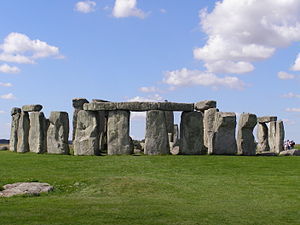
[image error]
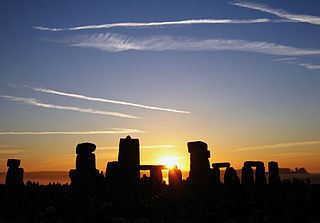
Sunrise over Stonehenge, Summer Solstice
 by Rosemary Hill (no photo)
by Rosemary Hill (no photo) by John North (no photo)
by John North (no photo) by David Souden (no photo)
by David Souden (no photo) by David Lewis-Williams (no photo)
by David Lewis-Williams (no photo)
 Thank you Bea some lovely pictures of Stonehenge. It must be one of the most instantly recognisable man made structures on earth. I have visited stonehenge about 3 or 4 times the first as a child on a family holiday at that time it was possible to actually touch the stones now you have to walk around the stones at a distance of several yards.
Thank you Bea some lovely pictures of Stonehenge. It must be one of the most instantly recognisable man made structures on earth. I have visited stonehenge about 3 or 4 times the first as a child on a family holiday at that time it was possible to actually touch the stones now you have to walk around the stones at a distance of several yards.I personally prefer Avebury as it is still possible to have contact with the stones one summer I visited at the summer soltice the atmosphere was truly magical the landscape lit with fires, the beating of drums .
Stonehenge Canadays framework
Functional efficency As the original function of stonehenge is still debated this is a difficult question to answer. However considerable effort and time was put into building the structure and numerous alterations were made over a long period of
time presumably efficency of function was important to the builders.
Aesthetic quality - I think the henge rates highly on this scale the circular shapes and setting within the landscape are very pleasing to the eye.
Materials and site because of the henges age any biodegradable materials used originally as part of the structure are no longer there for us to judge. However the the use of stones and the effort to transport some stones long distances shows a lot of attention was paid to the materials used. The henge is part of a larger pre historic landscape which probably looked very different to the landscape we see today.
Humanistic record for me the henge does intensify the human experience and the sense of connection with the past.
 Thanks so much for your contribution. I think that, even in its ruined state, Stonehenge combines beauty and mystery.
Thanks so much for your contribution. I think that, even in its ruined state, Stonehenge combines beauty and mystery.I was reading more about Stonehenge in A Global History of Architecture. I was fascinated to find out that Stonehenge continued to be transformed and added to from 3000 BCE to about 1800 BCE, or about 1200 years. The authors say that in about 2500 BCE, the axis was rotated about three degrees from an orientation to the moon to an orientation to the sun. When one thinks of the amount of work that went into moving and positioning the big stones and the stone age technology available, this was an enormous architectural achievement. I also didn't know that the climate was warmer then than it is now and more suitable for agriculture. I wonder if we will ever know more about the people that built this structure.
Here are some pictures of Avebury for those who have not seen it.
[image error]
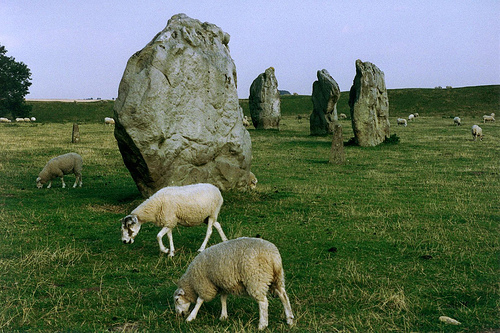
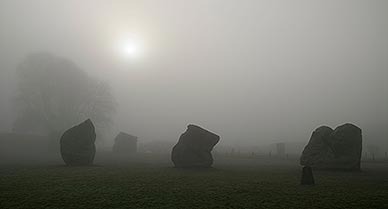
Wikipedia Link: http://en.wikipedia.org/wiki/Avebury
 by Francis D.K. Ching (no photo)
by Francis D.K. Ching (no photo) Aubrey Burl(no photo)
Aubrey Burl(no photo)
 Bea said "I wonder if we will ever know more about the people that built this structure."
Bea said "I wonder if we will ever know more about the people that built this structure."Durrington Walls which dating has shown is contemporary with the building of Stone henge and is 2 miles north-east has the remains of some of the houses that the early builders of the Henge probably lived in.
http://en.wikipedia.org/wiki/Durringt...
 by
by
 Francis Pryor
Francis Pryor byNeil Oliver
byNeil Oliver byMichael W. Pitts
byMichael W. PittsI have not personally read the above books however I have seen both Pryor and Oliver present and talk on various programmes on the subject matter and enjoy especially Olivers style and knowledge. Pitts book looks as if it would be a great book if you are interested in exploring more about Henges themselves
 Skara Brae
Skara Brae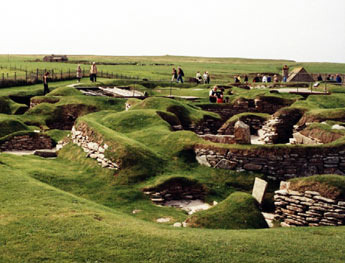
The beautiful neolithic village of Skara Brae in Orkney, Scotland. This site, which dates to approximately 3100 BCE, was uncovered by a serious storm which swept the British Isles in 1860. It was basically ignored until 1927 when the University of Edinburgh was given responsibility for studying it. Originally there were about 50 houses but some have been destroyed by weather since the village was first discovered. It is a World Heritage Site and is one of many neolithic wonders in Britain and is a "must see" when visiting the islands.
 Let's fast forward to say happy birthday to -
Let's fast forward to say happy birthday to - 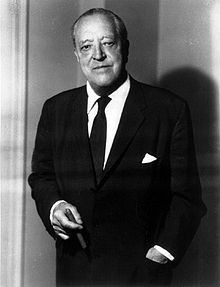
Ludwig Mies van der Rohe (March 27, 1886 – August 17, 1969) was a German-American architect. He is commonly referred to and addressed as Mies, his surname. Along with Walter Gropius, Le Corbusier and Oscar Niemeyer, he is widely regarded as one of the pioneering masters of modern architecture.
Mies, like many of his post-World War I contemporaries, sought to establish a new architectural style that could represent modern times just as Classical and Gothic did for their own eras. He created an influential twentieth century architectural style, stated with extreme clarity and simplicity. His mature buildings made use of modern materials such as industrial steel and plate glass to define interior spaces. He strived towards an architecture with a minimal framework of structural order balanced against the implied freedom of free-flowing open space. He called his buildings "skin and bones" architecture. He sought a rational approach that would guide the creative process of architectural design. He is often associated with the aphorisms "less is more" and "God is in the details".
http://en.wikipedia.org/wiki/Ludwig_M...
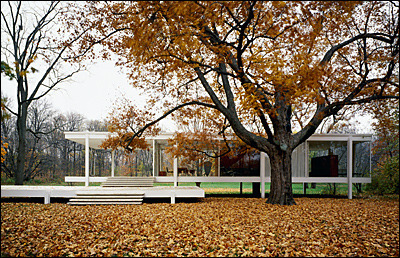

Farnsworth House, 1951, Plano, Illinois

Seagram Building, 1953, New York City

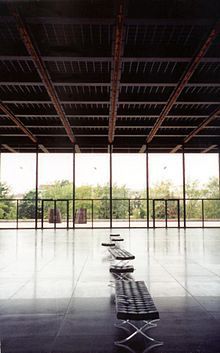
Interior is illuminated from around and below the viewer rather than from above
Neue Nationalgalerie, 1968, Berlin
 Claire Zimmerman (no photo)
Claire Zimmerman (no photo) by Franz Schulze (no photo)
by Franz Schulze (no photo) by William J.R. Curtis
by William J.R. Curtis by Kenneth Frampton
by Kenneth FramptonMies Van Der Rohe
 We need to add another name to the famous designers of wonderful buildings.....Frank Lloyd Wright.
We need to add another name to the famous designers of wonderful buildings.....Frank Lloyd Wright.Frank Lloyd Wright (born Frank Lincoln Wright, June 8, 1867 – April 9, 1959) was an American architect, interior designer, writer and educator, who designed more than 1,000 structures and completed 500 works. Wright believed in designing structures which were in harmony with humanity and its environment, a philosophy he called organic architecture. This philosophy was best exemplified by his design for Fallingwater (1935), which has been called "the best all-time work of American architecture". Wright was a leader of the Prairie School movement of architecture and developed the concept of the Usonian home, his unique vision for urban planning in the United States.
His work includes original and innovative examples of many different building types, including offices, churches, schools, skyscrapers, hotels, and museums. Wright also designed many of the interior elements of his buildings, such as the furniture and stained glass. Wright authored 20 books and many articles and was a popular lecturer in the United States and in Europe. His colorful personal life often made headlines, most notably for the 1914 fire and murders at his Taliesin studio. Already well known during his lifetime, Wright was recognized in 1991 by the American Institute of Architects as "the greatest American architect of all time."
Source: Wikipedia
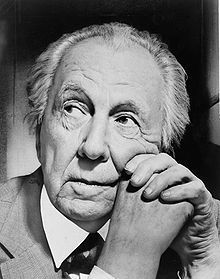
 Italian architect Gae Aulenti died October 31, 2012 at her home in Milan. She was 84. Her most famous work was the refashioning of the Paris Gare d'Orsay into the Musée d'Orsay. This is my favorite place in Paris. It is a shame that I had to wait until her death to find out it was designed by a woman.
Italian architect Gae Aulenti died October 31, 2012 at her home in Milan. She was 84. Her most famous work was the refashioning of the Paris Gare d'Orsay into the Musée d'Orsay. This is my favorite place in Paris. It is a shame that I had to wait until her death to find out it was designed by a woman.Aulenti also designed the Asian Art Museum in San Francisco, another outstanding spot.
May she rest in peace.
For more on her life and work see here: http://www.latimes.com/news/obituarie...

 World Architecture: The Masterworks
World Architecture: The Masterworks by Will Pryce
by Will PryceSynopsis
Will Pryce unveils a world of beauty and genius in this unparalleled, specially photographed survey of the world’s architectural master- pieces. More than 350 color photographs celebrate the finest buildings from over two thousand years of civilization: Hagia Sophia, the Gothic cathedrals of Europe, Islamic masterworks at Isfahan, the Taj Mahal, the Palace of Westminster, Gehry’s iconic Guggenheim Museum in Bilbao, and much more.
There are some eighty buildings featured, more than forty of which receive in-depth attention in detailed photo essays. Pryce’s accompanying texts and commentaries provide an extra dimension of understanding for the contexts in which they were created, and of the evolution of architecture through history.
 The link below provides a slide show of European forgotten and abandoned architectural treasures. It is really depressing to think that such beauty has been allowed to fall into ruin.
The link below provides a slide show of European forgotten and abandoned architectural treasures. It is really depressing to think that such beauty has been allowed to fall into ruin.http://realestate.aol.com/blog/2013/0...
 I think this goes here . . .
I think this goes here . . . A History of Future Cities
 by Daniel Brook
by Daniel BrookSynopsis
On May 27, 1703, Tsar Peter the Great founded a new capital on a barren Baltic marsh. Modeled on Amsterdam, he believed it would erase Russian backwardness and usher in a modernized, Westernized future. In the nineteenth-century Age of Imperialism, the British rebuilt Bombay as a tropical London, while three Western powers made Shanghai look just like home. And in our own time, the sheikh of Dubai has endeavored to transform his desert city into a Vegas-esque skyscraper-studded global hub. The cultural and historical threads that connect these cities and their conflicted embrace of modernity are brought into relief in Daniel Brook s captivating mix of history and reportage a story of architects and authoritarians, artists and revolutionaries who take these facsimiles of the West and turn them into crucibles of non-Western modernity. A History of Future Cities is both a crucial reminder of globalization s long march and an inspiring look into the possibilities of our Asian Century.
 Below is a model by Hitler's architect Albert Speer, of Germania ( a re-built Berlin) which Hitler envisioned would be built after the Nazis won the war.
Below is a model by Hitler's architect Albert Speer, of Germania ( a re-built Berlin) which Hitler envisioned would be built after the Nazis won the war.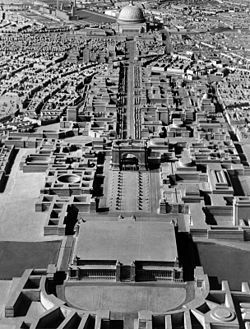
Welthauptstadt Germania ("World Capital Germania") refers to the projected renewal of the German capital Berlin during the Nazi period, part of Adolf Hitler's vision for the future of Germany after the planned victory in World War II. Albert Speer, the "first architect of the Third Reich", produced many of the plans for the rebuilt city in his capacity as overseer of the project, only a small portion of which was realized between the years 1937–1943 when construction took place.
Some projects, such as the creation of a great East-West city axis, which included broadening Charlottenburger Chaussee (today Straße des 17. Juni) and placing the Berlin victory column in the center, far away from the Reichstag, where it originally stood, were successfully completed. Others, however, such as the creation of the Große Halle (Great Hall), had to be shelved owing to the beginning of war. A great number of the old buildings in many of the planned construction areas were, however, demolished before the war and eventually defeat stopped the plans. (Source: http://en.wikipedia.org/wiki/Welthaup...)
 Curious about Frank Lloyd Wright? Try this book of historical fiction. I liked it a lot.
Curious about Frank Lloyd Wright? Try this book of historical fiction. I liked it a lot.Loving Frank
 by
by
 Nancy Horan
Nancy HoranSynopsis:
I have been standing on the side of life, watching it float by. I want to swim in the river. I want to feel the current.
So writes Mamah Borthwick Cheney in her diary as she struggles to justify her clandestine love affair with Frank Lloyd Wright. Four years earlier, in 1903, Mamah and her husband, Edwin, had commissioned the renowned architect to design a new home for them. During the construction of the house, a powerful attraction developed between Mamah and Frank, and in time the lovers, each married with children, embarked on a course that would shock Chicago society and forever change their lives.
In this ambitious debut novel, fact and fiction blend together brilliantly. While scholars have largely relegated Mamah to a footnote in the life of America’s greatest architect, author Nancy Horan gives full weight to their dramatic love story and illuminates Cheney’s profound influence on Wright.
Drawing on years of research, Horan weaves little-known facts into a compelling narrative, vividly portraying the conflicts and struggles of a woman forced to choose between the roles of mother, wife, lover, and intellectual. Horan’s Mamah is a woman seeking to find her own place, her own creative calling in the world. Mamah’s is an unforgettable journey marked by choices that reshape her notions of love and responsibility, leading inexorably ultimately lead to this novel’s stunning conclusion.
Elegantly written and remarkably rich in detail, Loving Frank is a fitting tribute to a courageous woman, a national icon, and their timeless love story.
 Burj Khalifa: The tallest man-made building in the world
Burj Khalifa: The tallest man-made building in the worldBurj Khalifa (Arabic: برج خليفة, "Khalifa tower"), known as Burj Dubai prior to its inauguration, is a skyscraper in Dubai, United Arab Emirates, and is the tallest man-made structure in the world, at 829.8 m (2,722 ft).
Construction began on 21 September 2004, with the exterior of the structure completed on 1 October 2009. The building officially opened on 4 January 2010, and is part of the new 2 km2 (490-acre) development called Downtown Dubai at the 'First Interchange' along Sheikh Zayed Road, near Dubai's main business district. The tower's architecture and engineering were performed by Skidmore, Owings and Merrill of Chicago, with Adrian Smith as chief architect, and Bill Baker as chief structural engineer. The primary contractor was Samsung C&T of South Korea.
In March 2009, Mohamed Ali Alabbar, chairman of the project's developer, Emaar Properties, said office space pricing at Burj Khalifa reached US$4,000 per sq ft (over US$43,000 per m²) and the Armani Residences, also in Burj Khalifa, sold for US$3,500 per sq ft (over US$37,500 per m²). He estimated the total cost for the project to be about US$1.5 billion.
The project's completion coincided with the global financial crisis of 2007–2012, and with vast overbuilding in the country; this led to high vacancies and foreclosures. With Dubai mired in debt from its huge ambitions, the government was forced to seek multibillion dollar bailouts from its oil-rich neighbor Abu Dhabi. Subsequently, in a surprise move at its opening ceremony, the tower was renamed Burj Khalifa, said to honour the UAE President Khalifa bin Zayed Al Nahyan for his crucial support.
Because of the slumping demand in Dubai's property market, the rents in the Burj Khalifa plummeted 40% some ten months after its opening. Out of 900 apartments in the tower, 825 were still empty at that time. However, over the next two and a half years, overseas investors steadily began to purchase the available apartments and office space in Burj Khalifa. By October 2012, Emaar reported that around 80% of the apartments were occupied.

It is but I was viewing it on a cloudy day (oh well) - I do have photos somewhere. Not as good as this view but nonetheless - the sky wasn't painted a deeper blue.
How many cloudy days are there in the desert - I managed to find them.
How many cloudy days are there in the desert - I managed to find them.
 The Silver Bridge crossing the Ohio River at Point Pleasant, WV was a beautiful piece of architecture. On this date, 46 years ago, the bridge collapsed, claiming 46 lives. A tragedy that resounded across the country.
The Silver Bridge crossing the Ohio River at Point Pleasant, WV was a beautiful piece of architecture. On this date, 46 years ago, the bridge collapsed, claiming 46 lives. A tragedy that resounded across the country.Before

After

 A beautiful book which highlights some of America's art deco architecture. Most buildings in the book are still extant but some have been lost to the wrecking ball......inexcusable.
A beautiful book which highlights some of America's art deco architecture. Most buildings in the book are still extant but some have been lost to the wrecking ball......inexcusable.American Art Deco: Architecture and Regionalism
 by Carla Breeze(no photo)
by Carla Breeze(no photo)Synopsis:
Art deco architecture flourished in large cities and small towns throughout America in the 1920s and 1930s. Many of the best examples office buildings, movie theaters, hotels, and churches are still in use. Deco architects, artists, and designers drew on European styles but were most committed to a style that grew organically, as they saw it, from their native soil. Two themes bound Deco buildings and their decorative schemes together: a regional pride that tied buildings to their specific locales and functions, and a growing national symbolism that asserted the buildings' identity as uniquely, independently American. American Art Deco features description sand over 500 color photographs of seventy-five lavish and innovatively designed buildings across the country that have been preserved both outside and in, giving the full scope of this beloved, exciting style.
 It is unfortunate that the great architect Stanford White is usually remembered by history as the man who was murdered by millionaire Harry Thaw for taking Thaw's wife, Evelyn Nesbitt, as his mistress.
It is unfortunate that the great architect Stanford White is usually remembered by history as the man who was murdered by millionaire Harry Thaw for taking Thaw's wife, Evelyn Nesbitt, as his mistress.This book is a photographic journey to some of White's most famous and beautiful designs.
Stanford White, Architect
 by Samuel G. White (no photo)
by Samuel G. White (no photo)Synopsis
Through all-new, full-color photography, Stanford White, Architect is the first book to explicitly feature the work of the principal genius of the illustrious American architecture firm of McKim, Mead & White. The firm was also a prime mover in the realm of residential design, with Stanford White as its visionary head. As an architect of opulent houses—in Newport, Rhode Island, along the Hudson, on the Long Island Gold Coast, and elsewhere—Stanford White had few peers. His genius for this form is expressed nowhere more wonderfully than in such personal masterpieces as his country home Box Hill and his city home in Gramercy Park. Along with residential commissions for such eminent American families as the Vanderbilts, Astors, Pulitzers, Paynes, and Whitneys, Stanford White lent his eye and hand to New York’s Pennsylvania Station, Brooklyn Museum, The American Academy in Rome, and the Boston Public Library, as well as many diverse commissions, including social clubs, public buildings, churches, monuments, university buildings, and many other forms, each of which is represented in this landmark volume.(
 A feast for the eyes. Who wouldn't want to live in one of these homes?
A feast for the eyes. Who wouldn't want to live in one of these homes?Masterpieces: Iconic Houses by Great Contemporary Architects
 by Beth Browne (no photo)
by Beth Browne (no photo)Synopsis:
Every great architect has an original vision. The ability of master architects to see the big picture, to create inclusive, responsive designs that embrace building, site, and interiors with subtlety and style, leads to their work gaining widespread praise and international acclaim. Their talent and ambition, along with an unfaltering attention to detail and flair for fusing art and architecture, combine to produce houses of unparalleled style and comfort.
This book presents an up-to-the-minute collection of residential work from these much-lauded practitioners, proving that architecture can always be re-imagined.
This invaluable new compendium of spectacular houses designed by architecture's brightest stars also provides unique insights into their personal design philosophies. Stunning architectural photography of each house is supplemented with detailed descriptions, plans, sections, and sketches, revealing the mastery behind each design. Project locations range from the USA to France, from Italy to Dubai, and from Hong Kong to Spain.
 Going to Paris anytime soon? It might pay to read this book before you go to get an idea of the interesting buildings that may not be as well known as Notre Dame.
Going to Paris anytime soon? It might pay to read this book before you go to get an idea of the interesting buildings that may not be as well known as Notre Dame.Paris Architecture 1900-2000
 by Jean-Louis Cohe (no photo)
by Jean-Louis Cohe (no photo)Synopsis:
A beautiful book that takes the form of an architectural stroll through Paris and its inner suburbs with architect and historian Jean-Louis Cohen, and psychologist and sociologist Monique Eleb. The authors' descriptions of public and residential buildings dating from 1900 to the present day are remarkably perceptive. Each building featured has been chosen for the contribution it makes to the current cityscape and the role it has played in the evolution of Paris.The tour starts at Hector Guimard's Castel Beranger apartment block of 1898 and the Church of St. Jean de Montmartre, which is an early example of reinforced concrete construction. Also features the Salvation Army Hostel by Le Corbusier and Pierre Jeanneret, Renzo Piano's Rue de Meaux housing development of 1993, and Pierre Charreau's Maison de Verre.
Brunelleschi's Dome: How a Renaissance Genius Reinvented Architecture
 by
by
 Ross King
Ross King
Synopsis:
By all accounts, Filippo Brunelleschi, goldsmith and clockmaker, was an unkempt, cantankerous, and suspicious man-even by the generous standards according to which artists were judged in fifteenth-century Florence. He also designed and erected a dome over the cathedral of Santa Maria del Fiore-a feat of architectural daring that we continue to marvel at today-thus securing himself a place among the most formidable geniuses of the Renaissance. At first denounced as a madman, Brunelleschi literally reinvented the field of architecture amid plagues, wars, and political feuds to raise seventy million pounds of metal, wood, and marble hundreds of feet in the air. Ross King's captivating narrative brings to life the personalities and intrigue surrounding the twenty-eight-year-long construction of the dome, opening a window onto Florentine life during one of history's most fascinating eras.
 by
by
 Ross King
Ross KingSynopsis:
By all accounts, Filippo Brunelleschi, goldsmith and clockmaker, was an unkempt, cantankerous, and suspicious man-even by the generous standards according to which artists were judged in fifteenth-century Florence. He also designed and erected a dome over the cathedral of Santa Maria del Fiore-a feat of architectural daring that we continue to marvel at today-thus securing himself a place among the most formidable geniuses of the Renaissance. At first denounced as a madman, Brunelleschi literally reinvented the field of architecture amid plagues, wars, and political feuds to raise seventy million pounds of metal, wood, and marble hundreds of feet in the air. Ross King's captivating narrative brings to life the personalities and intrigue surrounding the twenty-eight-year-long construction of the dome, opening a window onto Florentine life during one of history's most fascinating eras.
 Here is something a little different and very timely.
Here is something a little different and very timely.Design Like You Give a Damn: Architectural Responses to Humanitarian Crises
 by Architecture For Humanity
by Architecture For HumanitySynopsis
The greatest humanitarian challenge we face today is that of providing shelter. The physical design of our homes, neighborhoods and communities shapes every aspect of our live, yet where architects are most desperately needed, they can least be afforded. Design Like You Give a Damn is a compendium of innovative projects from around the world that demonstrate the power of design to improve lives. It offers a history of the movement toward socially conscious design, and showcases more than 80 contemporary solutions to such urgent needs as basic shelter, healthcare, education and access to clean water, energy and sanitation.
 If you have never been to NYC, read this book to see the different forms of architecture and the beauty of the buildings. If you are going to NYC or have been there before, this is the book to take with you. A wonderful resource.
If you have never been to NYC, read this book to see the different forms of architecture and the beauty of the buildings. If you are going to NYC or have been there before, this is the book to take with you. A wonderful resource.AIA Guide to New York City: The Classic Guide to New York's Architecture
 by
by
 Norval White
Norval WhiteSynopsis:
Since the AIA Guide to New York City was first published in 1967, it has been recognized as the ultimate guide to the metropolis's buildings, in all five boroughs -- Manhattan, Brooklyn, Queens, the Bronx, and Staten Island -- from nineteenth-century brownstones and tenements to modern high-rise apartments and museums. The latest edition of this urban classic takes a fresh look at the architectural treasures that define New York -- from its most characteristic landmarks to its less famous local favorites.
To prepare this edition -- the first revision since 1987 -- Norval White has visited and revisited more than 5,000 buildings, making this by far the most complete guide of its kind. This generously illustrated handbook presents the structures of the New York City--from the magnificent to the obscure -- in over 3,000 new photographs, more than 130 new maps, and hundreds of revised and new entries. Beyond the skyscrapers and historical buildings, the guide also leads the way to the city's bridges, parks, and public monuments.
From the tip of the Empire State Building to the brownstones in Brooklyn, the AIA Guide to New York City reveals how the city's spirit, fortitude, and character are captured and expressed in its architecture. Thoughtful and humorous descriptions include fascinating bits of local information that bring the city's history to life, telling the stories behind the bricks and mortar. Together, the maps, photographs, and expert critiques invite you on a special grand tour of the city at your own pace.
This guide is a definitive record of New York's architectural heritage and provides a compact, authoritative directory for lovers of New York City all over the world. Its portability and encyclopedic quality make it an ideal traveling companion for any walker in the city. For the sightseer, the architect, or anyone on a casual stroll, the AIA Guide to New York City is the book to grab on your way out the door.
 This is part of a series of famous architects.
This is part of a series of famous architects.Walter Gropius
 by Paolo Berdini(no photo)
by Paolo Berdini(no photo)Synopsis:
This series was the winner of the American Institute of Architects' prestigious "Award for Excellence in International Book Publishing". Each volume in this series is introduced with an essay on the architect, and a chronological or stylistic presentation of their most outstanding buildings and projects. No other series provides such a complete and concise summary of the world's leading architects' works. The volumes are fully illustrated in black-and-white with photos and project renderings.
 Gothic Architecture
Gothic Architecturehttp://en.wikipedia.org/wiki/Gothic_a...
Source: Wikipedia
For more:
 by Paul Frankl (no photo)
by Paul Frankl (no photo) by
by
 Erwin Panofsky
Erwin Panofsky
 What is Gothic Architecture?
What is Gothic Architecture?From Khan Academy
https://www.khanacademy.org/humanitie...
Source: Khan Academy
 The Splendour of English Gothic Architecture
The Splendour of English Gothic Architecture by John Shannon Hendrix (no photo)
by John Shannon Hendrix (no photo)Synopsis:
This book explains and celebrates the richness of English churches and cathedrals, which have a major place in medieval architecture. The English Gothic style developed somewhat later than in France, but rapidly developed its own architectural and ornamental codes. The author, John Shannon Hendrix, classifies English Gothic architecture in four principal stages: the early English Gothic, the decorated, the curvilinear, and the perpendicular Gothic. Several photographs of these architectural testimonies allow us to understand the whole originality of Britain during the Gothic era: in Canterbury, Wells, Lincoln, York, and Salisbury. The English Gothic architecture is a poetic one, speaking both to the senses and spirit.
 Gothic Architecture - Early English Period c. 1190 - c. 1250
Gothic Architecture - Early English Period c. 1190 - c. 1250Overview:
English Gothic is the name of the architectural style that flourished in England from about 1180 until about 1520.
As with the Gothic architecture of other parts of Europe, English Gothic is defined by its pointed arches, vaulted roofs, buttresses, large windows, and spires. The Gothic style was introduced from France, where the various elements had first been used together within a single building at the choir of the Basilique Saint-Denis north of Paris, built by the Abbot Suger and dedicated on 11 June 1144. The earliest large-scale applications of Gothic architecture in England are at Canterbury Cathedral and Westminster Abbey. Many features of Gothic architecture had evolved naturally from Romanesque architecture (often known in England as Norman architecture). This evolution can be seen most particularly at the Norman Durham Cathedral which has the earliest pointed ribbed high vault known.
English Gothic was to develop along lines that sometimes paralleled and sometimes diverged from those of continental Europe. Historians traditionally divide English Gothic into a number of different periods, which may be further subdivided to accurately define different styles. Gothic architecture continued to flourish in England for a hundred years after the precepts of Renaissance architecture were formalised in Florence in the early 15th century. The Gothic style gave way to the Renaissance in the later 16th and 17th centuries, but was revived in the late 18th century as an academic style and had great popularity as Gothic Revival architecture throughout the 19th century.
Many of the largest and finest works of English architecture, notably the medieval cathedrals of England are largely built in the Gothic style. So also are castles, palaces, great houses, universities, and many smaller unpretentious secular buildings, including almshouses and trade halls. Another important group of Gothic buildings in England are the parish churches, which, like the medieval cathedrals, are often of earlier, Norman foundation.
The Designation of styles in English Gothic architecture follow conventional labels given them by the antiquary Thomas Rickman, who coined the terms in his Attempt to Discriminate the Style of Architecture in England (1812–15). Historians sometimes refer to the styles as "periods", e.g. "Perpendicular period" in much the same way as an historical era may be referred to as the "Tudor period". The various styles are seen at their most fully developed in the cathedrals, abbey churches and collegiate buildings. It is, however, a distinctive characteristic of the cathedrals of England that all but one of them, Salisbury Cathedral, show great stylistic diversity and have building dates that typically range over 400 years.
Early English (c. 1180–1275)
Decorated (c. 1275–1380)
Perpendicular (c. 1380–1520)
Example of Early English Gothic:
The Salisbury Cathedral

Source: Wikipedia
Books mentioned in this topic
Representing Women (other topics)Women, Art, and Power and Other Essays (other topics)
Morality and Architecture: The Development of a Theme in Architectural History and Theory from the Gothic Revival to the Modern Movement (other topics)
A History of Western Architecture, 4th edition (other topics)
Baroque: Architecture, Sculpture, Painting (other topics)
More...
Authors mentioned in this topic
Linda Nochlin (other topics)Linda Nochlin (other topics)
David Watkin (other topics)
David Watkin (other topics)
Rolf Toman (other topics)
More...








This thread can also be used to discuss famous architects, famous architectural feats, designs and buildings.
Anything dealing with architecture can be discussed on this thread as long as it is not self promotion.